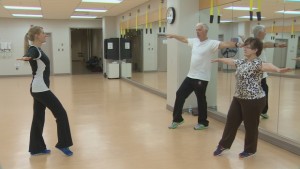‘To Fall or Not to Fall’: Exercises help seniors avoid falls
December 7, 2016
Originally published by CBC.
Falls account for 85 per cent of injury-related hospitalizations for seniors each year in Canada.

There is no better season than that of ice sidewalks and slippery pavement to get a receptive audience on how to prevent falls.
That is exactly what Alina Cress hopes, as she targets the over-65 crowd to beef up their strength and balance to help prevent falls.
Each year in Canada, falls account for about 85 per cent of injury hospitalizations for seniors. The top three reasons are: walking, walking on ice, and going up or down stairs, according to the Public Health Agency of Canada.
Alina Cress is the program co-ordinator with recreation services at the University of New Brunswick. For the past eight years she has been designing courses for the older adult — particularly in fall prevention. She said a mix of balance and strength training is the key.
“It helps strengthen the muscles that we require to hold us upright,” she said. “Our posture muscles, to keep our shoulders and hips stacked over each other, our core muscles that help to stabilize through our trunk, our hip muscles that help us stabilize through our pelvis and through our centre of gravity.
“The balance exercises help target sensory information that we get from our feet on the floor, and our visual sensations.”
Cress had Gisele Weatherhead and Archie Gilliss balancing on one leg, with arms outstretched in the mirrored room at UNB’s Currie Centre.
Weatherhead, 70, says falling is always in the back of her mind.
“It’s very scary, because if you fall you can break a limb, or concussion.”
But she says since she has been exercising three times a week at the UNB’s Currie Center, she notices a difference.
“I walk right now on icy surface; I have more control of my steps. I can balance.”
“It’s critical at our age, especially this time of year,” said Gilliss, 73.
Gilliss has been doing the same program since it started two years ago.
“It’s really tremendous how much that helps you,” he said. “When you first start the program, standing on one leg is a challenge. It’s still a challenge, but it’s a lot more comfortable than it was at the first. It helps tremendously, really.”
Cress cautioned that anyone deciding to take a class needs to ask how much experience and specialized training the instructor has in older adult training, to ensure they get the right exercises for their age.
“As we age, we lose muscle mass, we lose neural control, we lose our vision,” says Cress. “We can’t stop the aging process, but we can influence how we age.”
Category: Falls Prevention, News